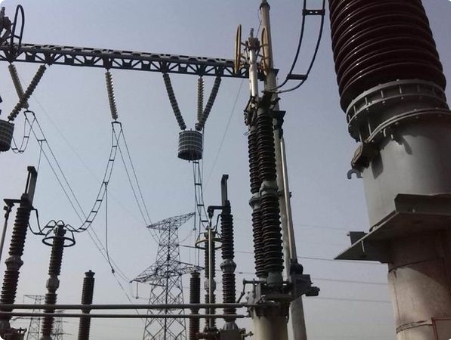
This article tells you what is the role of the voltage transformer?
“Voltage transformer is an indispensable electrical appliance in power transmission and power supply systems such as power plants and substations.
“
Voltage transformer is an indispensable electrical appliance in power transmission and power supply systems such as power plants and substations.
The function of the voltage transformer is to convert the high voltage into a 100V standard secondary voltage in proportion to the use of metering, instrumentation and relay protection. At the same time, the use of voltage transformers can isolate high voltages from electrical workers. For example, the actual value of both ends of the voltmeter is 100V, but the indicated value of the meter is the primary voltage value. ?Voltage transformers are special transformers that operate in an open circuit.
The primary fuse of the voltage transformer adopts RN2 or RN4 fuse, also called special insurance.
The rated current of the fuse is 0.5A, and the fuse is filled with quartz sand, so it has better arc extinguishing ability and larger breaking capacity. The fuse is made of nickel-chromium wire, with a total resistance of about 90Ω, which has limited effect of current. If an ordinary fuse is used to replace the one that can neither limit the current nor extinguish the arc, it is likely to burn the equipment, or even cause a power outage in a larger area.Nameplate Explanation of Voltage Mutual Inductance
1. Two JDJ-10s, the primary and secondary windings are connected to V type, and only the line voltage can be measured
2. JSJW-10 can measure line voltage and phase voltage with insulation monitoring. Under normal conditions, the voltage across the open triangle is zero. When the system is grounded, a voltage of about 100V will be generated at both ends of the open triangle, and the relay will act to issue a grounding alarm signal.

The function of the voltage transformer is to convert the high voltage into a standard secondary voltage of 100V or lower in a proportional relationship for protection, metering, and instrumentation devices.
At the same time, the use of voltage transformers can isolate high voltages from electrical workers. Although the voltage transformer is also a device that works according to the principle of electromagnetic induction, its electromagnetic structure relationship is exactly opposite to that of the current transformer.
The primary coil of the current transformer is wound with thick wire, and the number of turns is only one or a few turns, so its impedance is extremely small. When the primary coil is connected in series in the circuit under test, the voltage drop across it is extremely small. Although the number of turns of the secondary coil is large, under normal circumstances, its electromotive force E2 is not high, only about a few volts.
Since I1/I2=Ki (Ki is called the conversion ratio), so I1=KiI2
It can be seen that the current passing through the load is equal to the product of the current measured by the secondary coil and the conversion ratio Ki. If the ammeter is used with a dedicated current transformer, the scale of the ammeter can be marked according to the current value in the high-current circuit.
The maximum secondary current of the current transformer is usually designed as a standard value of 5A. The current transformers used in different current circuits are different, and the conversion ratios are 10/5, 20/5, 30/5, 50/5, 75/5, 100/5 and so on.

The high voltage is converted into a standard secondary voltage of 100V or lower according to a proportional relationship, which is used for protection, metering and instrumentation devices. At the same time, the use of voltage transformers can isolate high voltages from electrical workers. Although the voltage transformer is also a device that works according to the principle of electromagnetic induction, its electromagnetic structure relationship is exactly opposite to that of the current transformer. The secondary circuit of the voltage transformer is a high-impedance circuit, and the magnitude of the secondary current is determined by the impedance of the circuit. When the secondary load impedance decreases, the secondary current increases, so that the primary current automatically increases a component to satisfy the electromagnetic balance relationship between the primary and secondary sides. It can be said that the voltage transformer is a special transformer with limited structure and use form.
Voltage transformers are very similar to transformers in that they are used to transform the voltage on the line. However, the purpose of transformer voltage conversion is to transmit electrical energy, so the capacity is very large, and it is generally calculated in kVA or MVA; and the purpose of voltage transformer conversion is mainly for measuring instruments and relay protection devices. Power supply, used to measure the voltage, power and electric energy of the line, or used to protect the valuable equipment, motors and transformers in the line when the line fails, so the capacity of the voltage transformer is very small, generally only a few volt-ampere, dozens of Volt-ampere, the maximum does not exceed one thousand volt-ampere.

Why do you need to change the voltage on the line? This is because the voltages on the lines are different in size according to the different situations of power generation, transmission and consumption, and the difference is very different. Some are low-voltage 220V and 380V, and some are high-voltage tens of thousands of volts or even hundreds of thousands of volts. To directly measure these low-voltage and high-voltage voltages, it is necessary to make phase-phase low-voltage and high-voltage voltmeters and other instruments and relays according to the size of the line voltage. This will not only bring great difficulties to the production of the instrument, but more importantly, it is necessary to directly make a high-voltage instrument and measure the voltage directly on the high-voltage line. That is impossible, and absolutely not allowed.
If a voltage transformer is connected to the line to convert the voltage, then the low-voltage and high-voltage voltages on the line can be uniformly converted into one or several low-voltage voltages according to the corresponding ratio, as long as one or several types of voltage specifications are used. And relays, such as general-purpose 100V meters, can measure and monitor the voltage on the line through the Cray voltage transformer!
The Links: CM75DY-28H LM5Q32R


